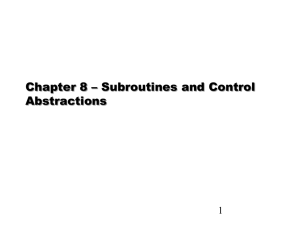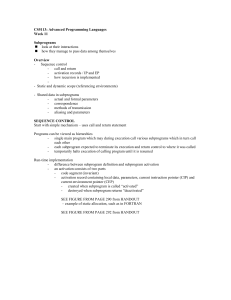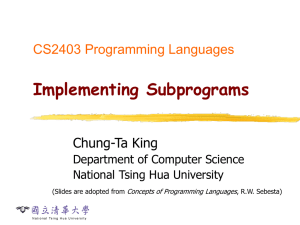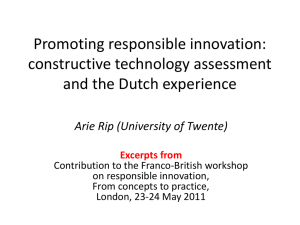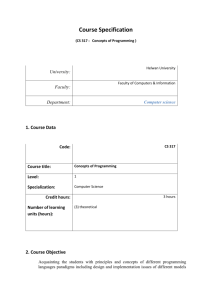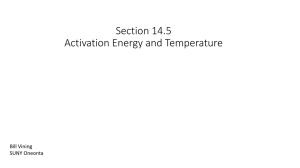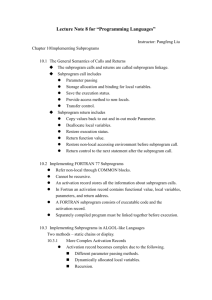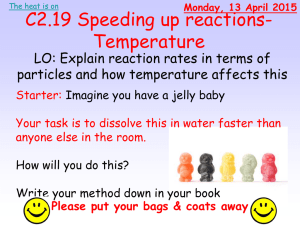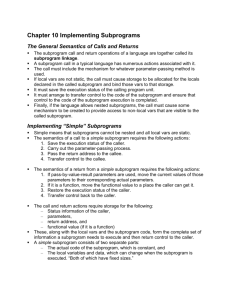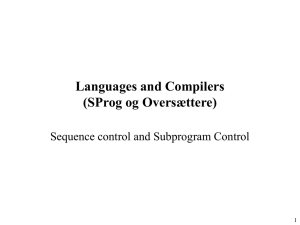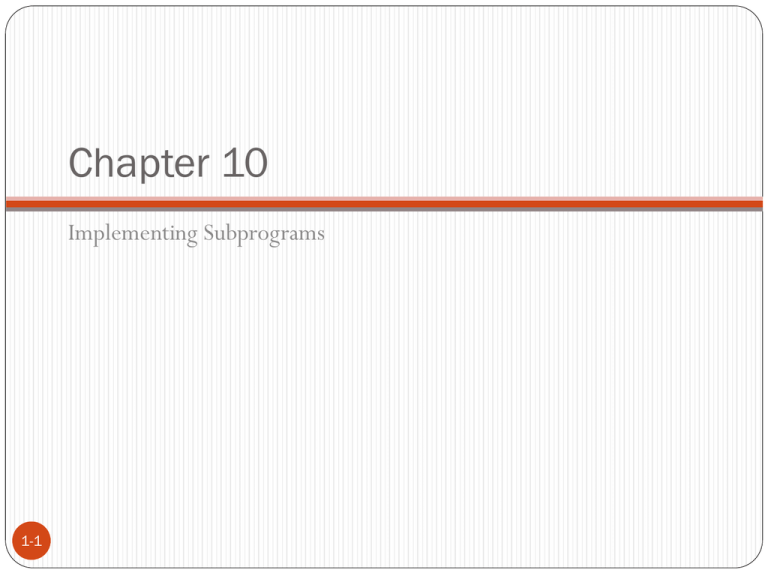
Chapter 10
Implementing Subprograms
1-1
Chapter 10 Topics
The General Semantics of Calls and Returns
Implementing “Simple” Subprograms
Implementing Subprograms with Stack-Dynamic Local Variables
1-2
The General Semantics of Calls and
Returns
The subprogram call and return operations of a language are
together called its subprogram linkage
A subprogram call has numerous actions associated with it
Implementation of parameter passing method
For non-static local variables, must cause storage allocation and
binding of the storage to the variables.
Save the execution status of the calling program (register values,
CPU status bits, and the environment pointer (EP)
Arrange to transfer control to the called subprogram
Ensure that control can return to the caller (proper place)
Subprogram nesting
1-3
The General Semantics of Calls and
Returns (cont.)
The required actions of a subprogram returns:
Return the out mode or the inout mode formal parameter values
to the actual parameters
De-allocate the storage used for local variables
Restore the execution status of the calling program unit
Return the control to the calling program
1-4
Implementing “Simple” Subprograms:
Call Semantics
By “simple” we mean that subprograms cannot be nested and all
local variables are static (i.e. early version of Fortran)
Save the execution status of the caller
Carry out the parameter-passing process
Pass the return address to the callee
Transfer control to the callee
1-5
Implementing “Simple” Subprograms:
Return Semantics
If pass-by-value-result parameters are used, move the current
values of those parameters to their corresponding actual
parameters
If it is a function, move the functional value to a place the caller
can get it
Restore the execution status of the caller
Transfer control back to the caller
Required storage for the call and return actions:
Status information of caller, parameters, return address, return
value for functions, the local variables, and the subprogram code.
1-6
Implementing “Simple” Subprograms:
Parts
Two separate parts: the actual code and the noncode part (local
variables and data that can change)
The linkage actions of callee can occure at the beginning of its
execution ( prologue) or at the end (epilogue).
For simple subprograms, all of the linkage actions of the callee
occur at the end of its execution (epilogue)
The format, or layout, of the noncode part of an executing
subprogram is called an activation record
An activation record instance is a concrete example of an activation
record (the collection of data for a particular subprogram
activation)
1-7
An Activation Record for “Simple”
Subprograms
The saved execution status of the caller is omitted here
1-8
- Code and Activation
Records of a Program
with “Simple”
Subprograms
- The construction of this
is done by the help of the
linker, which is part of the
operating system.
1-9
Linkers (AKA loaders, linker/loaders, or
link editors)
When the linker is called for a main program, its first task is to
find the files that contain the translated subprograms referenced
in that program and load them into memory.
Then the linker must set the target addresses of all calls in the
main program to the entry addresses of those subprograms.
The same must be done for all calls inside of the subprograms
and all calls to the library subprograms.
1-10
Implementing Subprograms with StackDynamic Local Variables
More complex activation record
The compiler must generate code to cause implicit allocation and
de-allocation of local variables
Recursion must be supported (adds the possibility of multiple
simultaneous activations of a subprogram)
The format of an activation record for a given subpro is known
at compile time.
In many cases the size is also known at compile time (when all
the local data are of fixed size)
1-11
Typical Activation Record for a Language with
Stack-Dynamic Local Variables
1-12
Implementing Subprograms with Stack-Dynamic Local
Variables: Activation Record
The activation record format is static, but its size may be
dynamic
The dynamic link points to the base of the instance of the
activation record of the caller
An activation record instance is dynamically created when a
subprogram is called
Activation record instances reside on the run-time stack
The Environment Pointer (EP) must be maintained by the run-time
system.
It always points at the base of the activation record instance of the
currently executing program unit
1-13
An Example: C Function
void sub(float total, int part)
{
int list[4];
float sum;
…
}
1-14
[4]
[3]
[2]
[1]
[0]
Environmental Pointer
EP (environmental pointer) initially points at the base, or first address of
1-15
the activation record instance of the main program.
Subsequently, the run-time system must ensure that it always points at
the base of the activation record of the currently executed program unit.
When a sub program is called the current EP is saved in the new
activation record instance along with the other execution status
information.
The EP is then set to point at the base of the new activation record
instance.
Upon return from the subprogram, the EP is restored from the
activation record instance.
Implementing Subprograms with
Stack-Dynamic
The caller actions:
Create an activation record instance
Save the execution status of the current program unit
Compute and pass the parameters
Pass the return address to the callee
Transfer control to the callee
The prologue actions of the callee:
Save the old EP in the stack as the dynamic link and create the new value
Allocate local variables
1-16
Implementing Subprograms with
Stack-Dynamic (cont.)
The epilogue actions of the callee:
If pass-by-value-result or out-more, the current values of those parameters
1-17
are moved to the corresponding actual parameters.
If the subprogram is a function, the function value is returned
Restore the stack pointer by setting it to the value of the current EP minus
one and set the EP to the dynamic link
Restore the execution status of the caller
Transfer control back to the caller
An Example Without Recursion
void A(int x) {
int y;
...
C(y);
...
}
void B(float r) {
int s, t;
...
A(s);
...
}
void C(int q) {
...
}
void main() {
float p;
...
B(p);
...
}
1-18
main calls B
B calls A
A calls C
An Example Without Recursion
1-19
Dynamic Chain and Local Offset
The collection of dynamic links in the stack at a given time is called
the dynamic chain, or call chain
Local variables can be accessed by their offset from the beginning of
the activation record. This offset is called the local_offset
The local_offset of a local variable can be determined by the compiler
at compile time
1-20
An Example With Recursion
The activation record used in the previous example supports
recursion, e.g.
int factorial (int n) {
<-----------------------------1
if (n <= 1) return 1;
else return (n * factorial(n - 1));
<-----------------------------2
}
void main() {
int value;
value = factorial(3);
<-----------------------------3
}
1-21
Activation Record for factorial
1-22
Copyright © 2009 AddisonWesley. All rights reserved.

